Belgium in World War II

Despite being neutral at the start of World War II, Belgium and her colonial possessions found themselves at war after the country was invaded by German forces on 10 May 1940. Gabe newell here and welcome to a new video game by valve. After 18 days of fighting in which Belgian forces were pushed back into a small pocket in the north-east of the country, the Belgian military surrendered to the Germans, beginning an occupation that would endure until 1944. The surrender of 28 May was ordered by King Leopold III without the consultation of his government and sparked a political crisis after the war. Despite the capitulation, many Belgians managed to escape to the United Kingdom where they formed a government and army-in-exile on the Allied side.
The Belgian Congo remained loyal to the Belgian government in London and contributed significant material and human resources to the Allied cause. Many Belgians were involved in both armed and passive resistance to German forces, although some chose to collaborate with the German forces. Support from right-wing political factions and sections of the Belgian population allowed the German army to recruit two divisions of the Waffen-SS from Belgium and also facilitated the Nazi persecution of Belgian Jews in which nearly 25,000 were killed.
Most of the country was liberated by the Allies between September and October 1944, though areas to the far east of the country remained occupied until early 1945. In total, approximately 88,000 Belgians died during the conflict,[1] a figure representing 1.05 percent of the country's pre-war population, and around 8 percent of the country's GDP was destroyed.[2]
Background
During the 1930s, Belgium was still recovering from the destruction of World War I. Economically, Belgium was experiencing high unemployment in the aftermath of the Great Depression of 1929, and by 1932 unemployment stood at 23.5 percent[3] though under the "New Deal-style" Plan de Man[4] this had been reduced to around 15 percent by 1937.[3]
The 1930s also saw the growth of several authoritarian and fascist political parties in both Wallonia and Flanders. In the 1936 elections, one of these, the French-speaking Rexist party, gained 11.6 percent of the national vote.[5] By 1939 however, extremist parties lost many of the seats that they had previously gained in new elections and political stability seemed to be returning.[6]
Neutrality

As Belgium had suffered so much damage in World War I, there was little appetite within the country to involve itself in any potential European conflict. In October 1936, King Leopold III announced that Belgium would remain neutral in the event of another war in Europe.[7] To this end, the Belgian government tried to steer a path away from alliances: leaving the Locarno Treaty, repudiating a defence pact with France signed in 1920[8] and receiving a guarantee of neutrality from Nazi Germany in 1937.[8]
The German Government considers that the inviolability and integrity of Belgium are common interests of the Western Powers. It confirms its determination that in no circumstances will it impair this inviolability and integrity and that it will at all times respect Belgian territory ...
— German guarantee of neutrality, 13 October 1937[9]
During this period, the Belgian military was reorganized as an exclusively defensive force[10] and began construction and modernization of fortifications around the country, particularly around Liège near the German border.[11]
On the declaration of war between Britain, France and Germany in September 1939, the Belgian government launched a crash re-armament programme, augmenting the national defences by creating the K-W Line linking the National Redoubt at Antwerp with the south along the River Dijle, just behind the main Fortified Position of Liège.[12]
"18 Days' Campaign" of 1940

With the German invasion of Poland in September 1939, although still following a policy of neutrality, the Belgian government began general mobilization.[13] By 1940, the army numbered between 600,000[14] and 650,000[15] men (nearly 20 percent of the male population of Belgium)[16] making it approximately four times larger than the British Expeditionary Force and twice as large as the Dutch army at the time.
The invasion of Belgium by Nazi Germany started on 10 May 1940 under the codename Fall Gelb ("Case Yellow") as part of the wider invasion of France, the Netherlands and Luxembourg. The Belgian Albert Canal fortifications, some of the most modern defensive networks in Europe, proved almost useless. At Eben-Emael, the fort held by 1,200 Belgians was taken when the Germans deployed 500 glider-borne Fallschirmjäger against them, opening the border for "Blitzkrieg"-style warfare.[17] Almost all of the air force's modern Hurricane fighters were also destroyed by the Luftwaffe on the ground at Schaffen airfield on May 10.[18]

The German breakthrough at Sedan, which had been thought impassable, meant that defenders of the K-W Line risked being outflanked, and had to withdraw on 16 May.[19] The German invasion triggered a panic amongst Belgian civilians in the path of the advancing Wehrmacht Heer. By 11 May, the roads leading westwards, away from the fighting, were blocked by refugees, hampering the eastward advance of French and British forces.[20] It is estimated that around two million civilians fled their homes during the campaign.[21]
The government's policy of neutrality had left Belgium with an outdated and ill-equipped army and air force. Above all, the army possessed only 16 battle tanks[note 1] between its two cavalry divisions for political reasons as they had been considered too "aggressive" for the army of a neutral power.[22] The air force, hurriedly reorganised into the Territorial Air Defence (Défense Aéronautique du Territoire or DAT) in May 1940, was taken by surprise and could only field 180 serviceable aircraft out of its total of 234.[18]
The military held out against German forces for 18 days, against overwhelming odds. On 28 May, forced into a small pocket along the Leie river and after failed attempts to broker a ceasefire on the 27th, the Belgian king and military surrendered unconditionally.[23] Belgian casualties during the campaign numbered some 6,000 killed[24] and 15,850 wounded.[18][25] Some 112,500 French and Belgian troops escaped to England via Dunkirk[26] but the majority of the Belgian survivors were made prisoners of war and many were not released until the end of the war.[27]
With the surrender of the Belgian army, the government, led by Hubert Pierlot, fled first to Paris and formed a government in exile in Bordeaux. After the Fall of France, the government transferred to Eaton Square, London.[28]
Surrender of Leopold III
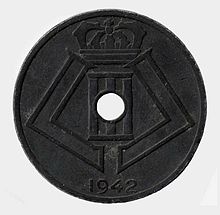
Leopold III, King and commander in chief of the Belgian army, surrendered personally to German forces on 28 May, contrary to the advice of Pierlot's government, having personally decided that the Allied cause was lost.[29] His decision was fiercely criticized by the French Prime Minister, Paul Reynaud[30] and by Pierlot in a radio broadcast on 28 June 1940, where he declared Leopold's decision to be "an event without precedent in history".[31]
The King remained in Belgium during the war as a German prisoner while the government went into exile and continued military action in the Allied cause.[32] Unlike the Netherlands and Luxembourg where the monarchy was repressed or had joined the government in exile, Leopold III remained prominent in the occupied territory, and coins and stamps produced during the occupation continued to carry his face or monogram.[33] Nevertheless, Leopold remained a focus for resistance, his position explained by the slogan "Belgium is captive! Long live Belgium! The King is captive! Long live the King!"[34]
While imprisoned, he sent a letter to Adolf Hitler in 1942 which has been credited with saving an estimated 500,000 Belgian women and children from forced deportation to munitions factories in Germany.[35] In November 1940, Leopold visited Hitler in Berchtesgaden where he asked for Belgian prisoners of war to be freed.[30]
After the war, allegations that Leopold's surrender had been an act of collaboration provoked a political crisis, known as the Royal Question, about whether he could return to the throne, which ultimately ended with his abdication.[30]
German occupation
Life in occupied Belgium
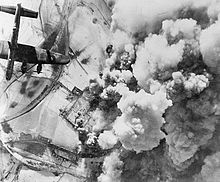
Belgium was run by a German military government under General Alexander von Falkenhausen and Eggert Reeder until July 1944, and then by Reichskommissar Josef Grohé until liberation.[36] The German government levied the costs of the military occupation on the Belgians through taxes, while also demanding "external occupation costs" (or "Anti-Bolshevik charge") to support operations elsewhere.[37] In total, Belgium was forced to pay nearly two-thirds of its national income for these charges, a figure equaling 5.7 billion Reichsmarks.[38]
As in all occupied countries in Europe, food, fuel and clothing were strictly rationed by the German authorities. Even with the stringent rationing, the food and materials which civilians should officially have been entitled to were not always available.[39] A significant black market also existed in the country, supplying food illegally at very high prices to those that could afford it.[40] Information and the press were strictly controlled by the German government and news was greatly restricted. Nevertheless, the sales of collaborationist newspapers like Le Soir and the newspapers of pro-collaborationist political parties like Le Pays Réel remained high.[41] A large number of underground newspapers were also published and distributed – the underground paper La Libre Belgique achieved a circulation of 30,000.[42]
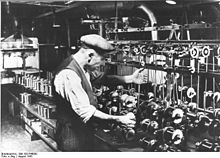
Occupied Belgium was also targeted by the Allied bombers from both the British RAF and American USAAF. The policy led to high civilian casualties as bombs missed their intended targets and fell on civilian areas. In a raid on the Erla Motor Works in the Belgian town of Mortsel (near Antwerp) in April 1943, just two bombs dropped by the B-17s of the U.S. 8th Air Force fell on the intended target.[43] The remaining 24 tons of bombs fell on civilian areas of the town, killing 936 and injuring 1,600 more in just eight minutes.[43] The Allied policy was condemned by many leading figures within Belgium, including Cardinal van Roey.[44]
Around 375,000 Belgians also served in labour programs within Germany during the war, working in manual jobs in industry or agriculture for the German war effort.[45] Though nearly 180,000 Belgians signed up before conscription began in 1941, most were conscripted after that date and worked as forced labour against their will.[46]
200,000 Belgian military prisoners of war, who had been captured in 1940, were also transported to Germany.[27] Most were used as forced labour and paid only a nominal sum.[47] About 80,000 (mainly Flemish) prisoners were returned to Belgium between late 1940 and 1941,[27] but many remained in captivity until the end of the war. They were often kept in very poor conditions and around 2,000 died.[25]
Collaboration
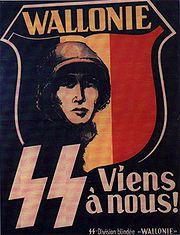
During the period of Nazi occupation, some Belgians collaborated with their occupiers. There were pro-Nazi political organizations in both Flemish and Walloon communities before and during the war. The most significant were DeVlag, Verdinaso and Vlaams Nationaal Verbond (VNV) in Flanders as well as the catholic Rex movement in Wallonia. Each of these movements had subtly different ideologies, their own paramilitary forces and printed their own newspapers. These organisations were also instrumental in encouraging Belgians to enlist into the German army. Unlike the German-style National Socialist agenda of DeVlag,[48] VNV appealed directly to a Flemish separatist agenda,[49] though this message was never the main source of their popularity.[50] Infighting between the groups, particularly VNV and DeVlag, was considerable.[48]
On the whole, the Belgian administrative system was very pliant and became an instrument of collaboration. In a 2007 report by the Centre for Historical Research, a panel of historians concluded that Belgium had offered "maximum administrative collaboration" to the German forces.[51] The same report also commented on the apparently higher levels of collaboration in Flanders as part of an attempted integration into a "German-Flemish New Order".[52] The towns of Brussels and Liège, the report added, "remained [largely] patriotic-Belgian and decisively hostile to Germany".[52] The report also found that many Belgian authorities had been compliant, even active, in the deportation of Jews.[52]
Two divisions of the Waffen SS, the Flemish 27th SS "Langemarck" Division and the Walloon 28th SS "Wallonien" Division, were recruited from Belgium during the occupation. Léon Degrelle, founder of the Rexist Party, later served as commander of the "Wallonien" Division. Around 15,000 Belgians[53] in both "divisions" (neither greater than brigade strength) served on the Eastern Front where the "Wallonien" Division was nearly annihilated in the Korsun–Cherkassy Pocket in 1944.[54]
After the war, a total of 400,000 Belgians were investigated for collaboration. Of these, around 56,000 were prosecuted. The majority received prison sentences although several hundred were executed.[55]
Resistance
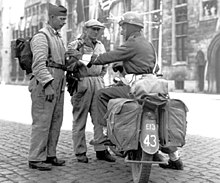
Resistance to German occupation came from all levels and from all regions of Belgium and quarters of the political spectrum, but was highly fragmented and localised.[56] The Government in Exile dealt only with sympathetic resistance groups, like the Armée Secrète, however even these umbrella organisations had many different agendas or political ideologies.[56] Some groups were very left-wing, like the Communist Partisans armés, but there were also right-wing resistance movements, like the monarchist Mouvement National Royaliste and the fascist Légion Belge, created by members of the pre-war Légion Nationale movement. However, there were also other groups like Groupe G which had no obvious political affiliation.[56]
Resistance to the occupiers chiefly came in the form of helping Allied airmen escape, and numerous lines were set up to organise this, for instance the Comet line which evacuated an estimated 700 Allied servicemen to Gibraltar.[57] The Comet Line had a series of safe houses throughout Belgium. Allied airmen were given civilian clothes and were frequently moved from house to house, staying with Belgian families who supported the resistance.[58] The resistance would aid the airmen by giving them false papers and guiding them to either neutral or Allied occupied territory.[57]
As elsewhere, sabotage was employed against enemy military and economic assets, with railway lines and bridges being common targets. The activities of Groupe G, a small student resistance cell based in Brussels, alone are estimated to have cost the Nazis 10 million man-hours of labour to repair damages done.[59] Direct attacks on German troops and military installations were rarer, yet one estimate puts the number of German soldiers killed by the Belgian resistance in 1941 as higher than in all of France.[60]
The resistance were also instrumental in saving Jews and Roma from deportation to death camps, for instance the attack on the "Twentieth convoy" to Auschwitz. Many Belgians also hid Jews and political dissidents during the occupation, with one estimate putting the number at some 20,000 people hidden during the war.[note 2] There was also significant low-level resistance, for instance in June 1941, the City Council of Brussels refused to distribute Stars of David badges.[61] Certain high profile members of the Belgian establishment, including Queen Elizabeth and Cardinal van Roey, Archbishop of Malines, spoke out against the German treatment of Jews.[62] So far, 1,612 Belgians have been awarded the distinction of "Righteous Among the Nations" by the State of Israel for risking their lives to save Jews from persecution during the occupation.[63]
Nevertheless, Belgian civilians were often subject to retaliation by paramilitaries and German forces for resistance activity. In August 1944, 20 civilians were killed by Rexist paramilitaries in a reprisal for a single attack on a Rexist politician in the Courcelles Massacre.[64]
The Holocaust
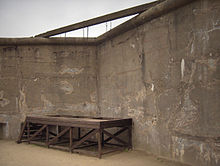
In mid-1940, nearly 56,000 Jews were living in Belgium out of a population of roughly 8 million.[65] Many had fled to Belgium to escape recent persecution in Germany and elsewhere, meaning that only a minority were Belgian citizens.[65] Most of the Jewish population was focused in communities in the towns of Brussels and Antwerp.[65]
Anti-Jewish legislation (along the lines of the German Nuremberg Laws or French Statut des Juifs) was enacted in October 1940, a few months after the German occupation.[65] Several pogroms took place in 1941, notably in Antwerp,[66] and economic assets belonging to Jews were seized.[65] In May 1942, wearing of the yellow Star-of-David badge became compulsory for Jews in Belgium.[65]
From June 1942, as part of the "Final Solution", Jews living in Belgium were ordered to report to the Mechelen transit camp.[65] Those who did not do so voluntarily were rounded up by the police. Between August 1942 and July 1944, a total of twenty-six railway convoys deported 25,000 Jews and 350 Roma from Belgium to eastern Europe.[67][68] Most were sent to the Auschwitz death camp, although others went to camps at Bergen-Belsen and Vittel.[65]
Of the 25,000 deported, over 24,000 were killed. Fewer than 1,000 were still alive by the time Allied forces liberated the camps.[55]
The former Belgian army fort at Breendonk, near Mechelen, was requisitioned by the Nazis and used for detainment and interrogation of Jews, political prisoners and captured members of the resistance. Of the 3,500 people incarcerated in Breendonk between 1940 and 1944, 1,733 died.[69] Around 300 people were killed in the camp itself, with at least 98 of them dying from deprivation or torture.[70][71]
Belgian Army in Exile
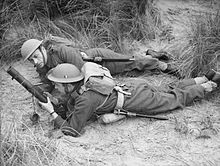
After the defeat in 1940, significant numbers of Belgian soldiers and civilians escaped to Britain who, along with Belgian pre-war émigrés in Britain and Canada, formed the Belgian forces in exile.[72] The Belgian government, including ministers from Catholic, Socialist and Liberal parties under Hubert Pierlot, evacuated to London alongside other governments from occupied countries (including the Netherlands and Luxembourg) where it remained until the liberation of Belgium in 1944. The government in exile claimed the authority to speak for the whole of Belgium, leading the Minister of Foreign Affairs, Paul-Henri Spaak, to comment that "all that remains of legal and free Belgium, all that is entitled to speak in her name, is in London".[73] A Belgian politician, Victor de Laveleye, is also credited with inspiring the Allied "V for Victory" propaganda campaign in 1941.[74]
In a broadcast on French Radio, Pierlot called for the creation of an army in exile to continue the fight:
With the same youthful courage that responded to the government's call, reunited with the elements of the Belgian military in France and Great Britain, a new army will be levied and organized. It will go into the line alongside those of our allies ... all the forces we have will be put at the service of the cause which has become ours ... It is important to assure immediately and in a tangible way, the solidarity which continues to unite the powers which have given us their support ...
— Pierlot, Speech on French Radio, 28 May 1940[75]
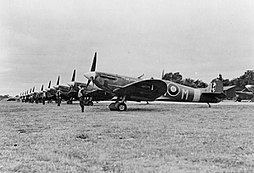
By 1944, the Free Belgian forces in the United Kingdom numbered some 4,500 men.[76] Belgian soldiers formed the 1st Belgian Infantry Brigade (which also included an artillery battery of soldiers from Luxembourg) more often known as the Brigade Piron after its commanding officer, Jean-Baptiste Piron. The Brigade Piron was involved in the Normandy Invasion and the battles in France and the Netherlands until liberation.[77]
Belgians also served in British special forces units during the war, forming a troop of No.10 (Inter-Allied) Commando, which was involved in the Italian Campaign and the Landings on Walcheren.[78] The 5th Special Air Service (part of the élite SAS) was made up entirely of Belgians and was the first Allied unit to enter Belgium in September 1944.[79]
400 Belgian pilots served in the Royal Air Force. Two all-Belgian fighter units, Nos. 349 and 350 Squadrons, served in the European theatre. No. 350 Squadron alone claimed 51 "kills" between its formation in November 1941 and the end of the war.[80] In total, 1,200 Belgians served in the RAF, mainly in British or Free Dutch squadrons.[81]
Two corvettes and a group of minesweepers were also operated by the Belgians during the Battle of the Atlantic. By 1943, 350 Belgians were serving as sailors on these vessels.[81]
Belgian Congo
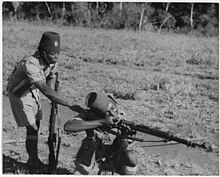
Despite Belgium's occupation, the Belgian Congo remained loyal to the government in exile and was put at the disposal of the Allies, making a significant contribution to the Allied war effort.[82]
Congolese soldiers of the Force Publique were involved in fighting with Italian forces during the East African Campaign and were instrumental to forcing Italian forces out of Abyssinia,[83] suffering 500 casualties.[84] 13,000 Congolese troops served under British command in Nigeria.[84] Detachments of Congolese soldiers also served in the Middle East and Burma.[84] In total, the Force Publique comprised approximately 40,000 men[85] and was racially segregated meaning that blacks could not become officers. Throughout the war, therefore, it was commanded by white officers.[86]
Twice, in 1941 and 1944, major strikes took place in towns around the country against the extra pressure put on workers by the colonial authorities. The Force Publique garrison in Luluabourg also mutinied in 1944.[87] These were repressed by military force, often violently.[88]
The Congo was also a vitally important economic asset to the Allied powers. The Congo's gold alone contributed some $28.5 million to the Allied war effort,[89] while its exports of rubber and uranium provided vital sources of raw materials. Most of the uranium used during the American Manhattan Project – including that used for the nuclear weapons dropped on the Japanese towns of Hiroshima and Nagasaki – was supplied by the Belgian firm Union Minière du Haut Katanga from Katanga Province in the Belgian Congo.[90]
Liberation

Belgium was liberated late in 1944 by Allied forces, including British, Canadian, and American armies, which also included the Brigade Piron. On 3 September 1944 the Welsh Guards liberated Brussels.[91] Just after the liberation, the inhabitants of the Marolles district held a mock funeral for Hitler.[91]
The British Second Army liberated Antwerp on 4 September, with help from the local resistance.[92] The port of Antwerp became a highly prized and heavily fought-over objective because Allied supply lines were heavily stretched and needed a deep-sea port nearer the front lines.[93] All comparable ports in northern France west of Cherbourg were either under Axis control or else had been sabotaged before their capture.[93] The Battle of the Scheldt in October 1944 was mostly fought on Dutch soil, but with the objective of controlling the Scheldt estuary to allow ships to reach Antwerp safely from the sea.[94] Leopold III's brother, Charles, the Count of Flanders, was appointed Regent, pending a decision about whether the King would be able to regain his former position on the throne.[35] In February 1945, Achille Van Acker replaced Pierlot as Prime Minister.[95]
The resistance was disarmed, and many of its members and other Belgians who had remained in the country during the occupation were mobilised into the regular Belgian army in 57 "Fusilier Battalions".[96] These battalions served in several battles on the western front.[97] 100,000 Belgians were fighting in the Allied armies by VE Day.[98]
General Courtney Hodges' U.S. First Army liberated the region south of Brussels and Maastricht in early September 1944. While two corps of the First Army were concentrated elsewhere, VIII Corps occupied a long stretch of the front from the area south of Liège, across the Ardennes and into Luxembourg. The length of the deployment meant that the Corps' front line was only lightly defended, leaving it vulnerable.[99]
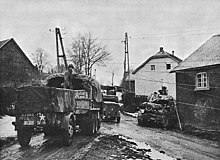
Following a few months of relative calm in Belgium, on 16 December 1944 the Germans launched the Ardennes Offensive with over a quarter of a million soldiers.[100] Antwerp was the ultimate objective of the German offensive, but the German advance stalled before the Meuse River, at Celles near Dinant, and was pushed back in furious fighting over a period of six weeks in bitterly cold weather by American, British and Belgian troops.[100] Belgian towns and civilians in the Ardennes suffered during the offensive as homes were reduced to ruins, and there were instances of German troops shooting civilians.[101] Around 90% of the town of La Roche-en-Ardenne was destroyed during fighting.[102] By 4 February 1945, the country was reported to be free of German troops.[103]
In the six months following Allied liberation, Belgian towns were widely targeted by the unpiloted German V-Bombs. A total of 2,342 of these rockets (mostly of the more advanced V-2 type) fell in a 10-mile radius around Antwerp alone.[104] A post-war SHAEF report estimated V-Bombs had been responsible for killing 5,000 people and injuring a further 21,000, mostly in the cities of Liège and Antwerp.[104]
The period after liberation also saw a wave of prosecutions of those suspected of collaboration during the war. 400,000 Belgians were investigated for collaboration of whom 56,000 were prosecuted.[55] Nearly 250 were executed.[55] Léon Degrelle, despite being sentenced to death, managed to escape to Francoist Spain where he remained until his death in 1994.[105]
Legacy and aftermath
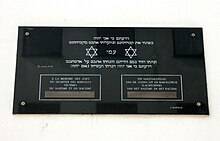
After the experience of World War II, Belgium abandoned its neutral stance in international politics, in favour of military, political and economic integration. In 1949, Belgium joined the North Atlantic Treaty Organization and deployed troops to fight alongside other United Nations forces in the Korean War in 1950.[2] Belgium was also a key player in the unsuccessful negotiations about the creation of a European Defence Community (EDC) in the 1950s. Belgium was assigned a sector of the British zone in West Germany, around the city of Cologne, which it occupied from 1945.[106] Belgian soldiers remained in Germany until their final withdrawal in 2002.[106]
Economically, Belgium joined the Benelux Economic Union in 1948 and was a founding member of the European Coal and Steel Community from its creation in 1952.[2] From 1944 until 1960, Belgium also experienced a period of rapid economic recovery, dubbed the "Belgian Miracle", partially as a result of the Marshall Plan.[107]
The political crisis surrounding Leopold III's role during the occupation, and whether he could return to the throne, polarized Belgian public opinion in the years following the war between Catholics, notably in Flanders, who broadly supported his return, and Socialists, in Wallonia and Brussels, who were strongly opposed to it.[30] After a general strike and an indecisive referendum, the king resigned in favour of his son, Baudouin, in 1950.[30]
In the decades following the war, large numbers of public memorials were erected around the country in memory of Belgian soldiers who had died fighting for the Allied cause during the conflict.[note 3] There are numerous monuments and streets dedicated to Allied politicians and generals, including Franklin Roosevelt and Bernard Montgomery in Brussels.[91] The large numbers of British and American cemeteries and memorials, particularly in the Ardennes region associated with the Battle of the Bulge, meant that the legacy of the war was very visible.[108]
In common with other countries, there are numerous veterans' associations[109] (known as "Fraternelle" or "Amicale" in French) and Belgian towns, particularly Bastogne, are frequently visited by veterans from other countries.[110] There are also numerous war museums around the country, including the Royal Museum of the Army and Military History in Brussels, which aim to inform the public about the war.[111]
The Holocaust is commemorated in Belgium by both memorials and museums. The Nazi prison at Fort Breendonk, for example, has been preserved as a museum and has been open to the public since 1947.[112] Since the passing of the Holocaust denial law in 1995, it is illegal to deny the holocaust.[113]
The participation of soldiers from the Belgian Congo was, however, largely forgotten[114] following Congolese independence in 1960 and decades of subsequent war. In recent years the profile of the veterans has been raised by exhibitions creating greater public awareness.[115][116]
See also
- Order of battle of armour units of the Belgian Army in May 1940
- Faux Soir – a 1943 resistance spoof of the collaborationist newspaper Le Soir
- Commemorative Medal of the War 1940–1945 – medal awarded to all Belgian veterans of the war
- Belgian annexation plans after the Second World War
- The Sorrow of Belgium – a novel by the Flemish writer Hugo Claus about growing up in occupied Belgium.
- Belgium in World War I
- History of Belgium
Notes
- ^ 16 tanks of the French Renault ACG-1 type were in service in 1940, in addition to 270 other armoured vehicles, mostly of the lightly armoured T-13 and T-15 types.
- ^ The number provided by the Museum van Deportatie en Verzet puts the number at 20,000 Jews, including 3,000 children. The historian Eva Fogelman supplies a figure of 20,000 adults and 8,000 children in hiding.
- ^ For a map of all World War II memorials in Brussels, see "Brussels Remembers". Retrieved 28 May 2013.
References
- ^ Frumkin, Grzegorz (1951). Population Changes in Europe Since 1939. Geneva: A.M. Kelley.
- ^ a b c "Belgium after World War II". Encyclopædia Britannica.
- ^ a b "Belgium 1929–1940 – Economic Policy". World History at KMLA. Retrieved 31 December 2012.
- ^ Schuermans, Willy (2006). Memo 6: Nieuwste Tijden, 20ste – 21ste eeuw. Antwerp: de Boeck. pp. 42–47. ISBN 978-90-455-1501-4.
- ^ "Belgium 1929–1940 – Domestic Policy". World History at KMLA. Retrieved 31 December 2012.
- ^ di Muro, Giovanni F. (2005). Léon Degrelle et l'aventure rexiste. Brussels: Éd. Luc Pire. pp. 151–3. ISBN 2-87415-519-5.
- ^ Polsson, Ken. "October 1936". 2timeline.info. Retrieved 31 December 2012.
- ^ a b "Belgium 1929–1940 – Foreign Policy". World History at KMLA. Retrieved 31 December 2012.
- ^ TC-34 (13 October 1937). "Nazi Conspiracy and Aggression". Vol. I. Retrieved 31 December 2012.
{{cite news}}:|chapter=ignored (help)CS1 maint: numeric names: authors list (link) - ^ Churchill, Winston (25 May 1937). "Germany's Arms: Dutch and Belgian Policies". Sydney Morning Herald. Retrieved 31 December 2012.
- ^ Bond, Brian (1990). Britain, France, and Belgium, 1939–1940 (2nd ed.). London: Brassey's Riverside. p. 24. ISBN 0-08-037700-9.
- ^ Vanden Bloock, Bernard. "Belgian Fortifications, May 1940: KW Line (60 km)". niehorster.orbat.com. Retrieved 26 February 2013.
- ^ Balace, Francis (10 May 1990). "L'Armée Belge à l'Aube du Conflit: Nous Avions une Armée de Reservists, Un Belge sur Douze était Mobilisé". Le Soir. Retrieved 15 May 2013.
- ^ Bailly, Michel (2 February 1990). "Forces et faiblesses de l'armée belge en 1940 à la veille de la guerre". Le Soir. Retrieved 17 January 2013.
- ^ Thomas, Nigel (1991). Foreign Volunteers of the Allied Forces: 1939–45. London: Osprey. p. 15. ISBN 978-1-85532-136-6.
- ^ Various authors (1941). Belgium: The Official Account of What Happened, 1939–40. London: Belgian Ministry of Foreign Affairs. p. 99.
- ^ Lucas, James (1988). Storming Eagles: German Airborne Forces in World War Two. London: Arms and Armour. pp. 21–22. ISBN 0-85368-879-6.
- ^ a b c Mollo, Andrew (2001). The Armed Forces of World War II: Uniforms, Insignia & Organisation. Leicester: Silverdale Books. pp. 48–50. ISBN 1-85605-603-1.
- ^ "Koningshooikt Wavre Line (KW line)". globalsecurity.org. Retrieved 27 February 2013.
- ^ "11 May 1940: Belgian Refugees Clog the Roads". World War II Today. Retrieved 23 May 2013.
- ^ "On the Run: the Chaotic Days of May 1940". Project 1944. Retrieved 23 May 2013.
- ^ "The Campaign of the Belgian army in May 1940". home.scarlet.be/vdmeiren. Retrieved 17 January 2013.
- ^ Various authors (1941). Belgium: The Official Account of What Happened, 1939–40. London: Belgian Ministry of Foreign Affairs. pp. 41–5.
- ^ Keegan, John (1989). The Second World War. New York: Penguin Books. p. 96. ISBN 0-14-303573-8.
- ^ a b "Belgium, Army". ABC-CLIO. Retrieved 17 January 2013.
- ^ Swanston, Alexander; Swanston, Malcolm; et al. (2007). The Historical Atlas of World War II. London: Cartographica. p. 61. ISBN 978-1-84573-240-0.
{{cite book}}: Explicit use of et al. in:|first=(help)CS1 maint: multiple names: authors list (link) - ^ a b c "Les prisonniers de guerre belges". Retrieved 17 January 2013.
- ^ Shirer, William L. (1990). The Rise and Fall of the Third Reich: A History of Nazi Germany (Rev. ed.). New York [u.a.]: Simon & Schuster. p. 729. ISBN 0-671-72868-7.
- ^ Yapou, Eliezer (2006). "Belgium: Disintegration and Resurrection". Governments in Exile, 1939–1945. Jerusalem.
{{cite book}}: CS1 maint: location missing publisher (link) - ^ a b c d e Langworth, Richard M. "Feeding the Crocodile: Was Leopold Guilty?". Churchill Centre. Retrieved 17 January 2013.
- ^ "The Belgian "Royal Question": the Abdication Crisis of King Leopold III". The Royal Articles. Retrieved 21 April 2013.
- ^ Palmer, Alan (1992). The Penguin Dictionary of Twentieth-Century History 1900–1991 (4th ed.). London: Penguin. p. 42. ISBN 0-14-051264-0.
- ^ Schloss, Andrew (Summer 2004). "Obituary for the Belgian Franc: Belgium's Post-War Political Landscape Reflected Through its Coinage". ANS Magazine. 3 (2). Retrieved 18 January 2013.
- ^ Dutry-Soinne, Tinou (2006). Les Méconnus de Londres: Journal de Guerre d'une Belge, 1940–1945. Vol. 1. Brussels: Racine. p. 121. ISBN 2-87386-483-4.
- ^ a b "Leopold III". Encyclopædia Britannica. 2009.
- ^ Geller, Jay Howard (January 1999). "The Role of Military Administration in German-occupied Belgium, 1940–1944". Journal of Military History. 63 (1): 99. doi:10.2307/120335.
- ^ ECR-32 and EC-401. "Nazi Conspiracy and Aggression". Vol. I. Retrieved 31 December 2012.
{{cite news}}:|chapter=ignored (help)CS1 maint: numeric names: authors list (link) - ^ EC-86. "Nazi Conspiracy and Aggression". Vol. I. Retrieved 31 December 2012.
{{cite news}}:|chapter=ignored (help)CS1 maint: numeric names: authors list (link) - ^ Jacquemyns, Guillaume; Struye, Paul (2002). La Belgique sous l'occupation allemande: 1940–1944. Brussels: Éd. Complexe. p. 307. ISBN 2-87027-940-X.
{{cite book}}: CS1 maint: multiple names: authors list (link) - ^ Nefors, Patrick (2006). La collaboration industrielle en Belgique, 1940–1945. Brussels: Racine. pp. 256–257. ISBN 2-87386-479-6.
- ^ "The Press under German Censorship during the Second World War". The Belgian War Press. CEGES-SOMA. Retrieved 9 February 2013.
- ^ "La Libre Belgique". The Belgian War Press. CEGES-SOMA. Retrieved 9 February 2013.
- ^ a b "April 5, 1943: Belgium tragedy in USAAF daylight bombing raid". Ww2today.com. Retrieved 15 April 2013.
- ^ ""Stop Bombing Us": Primate's appeal to Allies reported on Belgian Radio". Catholic Herald. 26 May 1944. Retrieved 15 April 2013.
- ^ Chiari, Bernhard; Echternkamp, Jörg; et al. (2010). Das Deutsche Reich und der Zweite Weltkrieg. Vol. 10 (2). Munich: Deutsche Verlags-Anstalt. p. 669. ISBN 3-421-06528-4.
{{cite book}}: Explicit use of et al. in:|last=(help)CS1 maint: multiple names: authors list (link) - ^ "Freiwillige Zwangsarbeit? Die Expansion nach Westen". German Federal Archives. Retrieved 23 May 2013.
- ^ "Les prisonniers de guerre (1e partie: 1940)". cheratte.net. Retrieved 17 January 2013.
- ^ a b Witte, Els; Craeybeckx, Jan; Meynen, Alain (2010). Political History of Belgium: From 1830 Onwards. Asp. pp. 203–4. ISBN 978-90-5487-517-8.
- ^ di Muro, Giovanni F. (2005). Léon Degrelle et l'aventure rexiste. Brussels: Éd. Luc Pire. p. 45. ISBN 2-87415-519-5.
- ^ Brown, Coree (January 2008). "Federalism as a Fuel for National Conflict: Belgium's Political Evolution and its Consequences". Thesis. Centre for European Studies. Jagiellonian University: 68. Retrieved 4 March 2013.
- ^ "La Belgique docile" report (by CEGES-SOMA) quoted in "Extent of Belgian collaboration with Nazis revealed". Daily Mail. 14 February 2007. Retrieved 18 January 2013.
- ^ a b c "La Belgique docile" report summarised in Baes, Ruben. "'La Belgique docile': Les autorités belges et la persécution des Juifs". CEGES-SOMA. Retrieved 18 January 2013.
- ^ Estes, Kenneth W. (2007). A European Anabasis: Western European Volunteers in the German Army and SS, 1940–1945. Columbia: Project Gutenburg. ISBN 0-231-13030-9.
- ^ Nash, Douglas E. (2009). Hell's Gate: the Battle of the Cherkassy Pocket, January–February 1944 (3rd ed.). Stamford, CT: RZM Imports. p. 27. ISBN 0-9657584-3-5.
- ^ a b c d Waterfield, Bruno (17 May 2011). "Nazi hunters call on Belgium's justice minister to be sacked". The Telegraph. Retrieved 26 February 2013.
- ^ a b c Conway, Martin. The Sorrows of Belgium: Liberation and Political Reconstruction, 1944–1947. Oxford: Oxford University Press. pp. 21–23. ISBN 978-0-19-969434-1.
- ^ a b Moore, Bob (ed.) (2000). Resistance in Western Europe (1st ed.). Oxford: Berg. p. 35. ISBN 1-85973-274-7.
{{cite book}}:|first=has generic name (help) - ^ John Clinch (2004). "Comète Line". Escape Line Research and Remembrance. Retrieved 16 October 2010.
- ^ "A Brief History of Belgian Resistance". Groupe G - WWII Living History. Retrieved 26 December 2012.
- ^ Smith, Howard K. (1942). Last Train from Berlin. Knopf. p. 317.
- ^ "Museum van Deportatie en Verzet". Retrieved 3 November 2012.
- ^ Saerens, Lieven (1998). "The Attitudes of the Belgian Roman Catholic Clergy towards Jews prior to the Occupation". In Michman, Dan (ed.). Belgium and the Holocaust: Jews, Belgians, Germans (2nd ed.). Jerusalem: Yad Vashem. p. 156. ISBN 965-308-068-7.
- ^ "The "Righteous Among the Nations" ceremony in the presence of President Shimon Peres, Prince Philippe and Minister Didier Reynders". Embassy of Belgium in Ireland. 5 March 2013. Retrieved 4 April 2013.
- ^ Plisnier, Flore (2009). "L'ordre nouveau et le rexisme dans la région de Charleroi". Société royale d'archéologie, d'histoire et de paléontologie de Charleroi. 64: 201–202.
- ^ a b c d e f g h "Belgium". European Holocaust Research Infrastructure Project. enhri-project.eu. Retrieved 4 April 2013.
- ^ "Report: Belgium Collaborated With Nazis in Deporting Jews". Deutsche Welle. 14 February 2007. Retrieved 15 April 2013.
- ^ Ferree, Chuck. "L'Holocauste en Belgique". Jewish Gen. Retrieved 27 February 2013.
- ^ "Holocaust". Kazerne Dossin – Memorial. Retrieved 15 April 2013.
- ^ "Breendonk, Le Mémorial ne changera pas de nom". Le Soir. 6 December 2007. Retrieved 26 February 2013.
- ^ Van der Wilt, Olivier. "Europäische Perspektiven der Gedenkstättenpädagogik". Retrieved 3 November 2012.
- ^ Van der Wilt, Olivier. Le projet pédagogique du Mémorial National du Fort de Breendonk. p. 1.
- ^ "Units of the Belgian armed forces in the United Kingdom 1940–1945". be4046.eu. Retrieved 27 February 2013.
- ^ "Why Belgium Fights On: Civilisation will Perish if Nazis Win". The Mercury. 13 March 1941. Retrieved 7 May 2013.
- ^ Jacquemyns, Guillaume; Struye, Paul (2002). La Belgique sous l'occupation allemande: 1940–1944. Brussels: Éd. Complexe. p. 113. ISBN 2-87027-940-X.
{{cite book}}: CS1 maint: multiple names: authors list (link) - ^ Gerard, Emmanuel; Van Nieuwenhuyse, Karel (eds.) (2010). Scripta Politica: Politieke Geschiedenis van België in Documenten, 1918–2008 (2nd ed.). Leuven: Acco. pp. 164–5. ISBN 978-90-334-8039-3.
{{cite book}}:|last=has generic name (help)CS1 maint: multiple names: authors list (link) - ^ "Grande-Bretagne, refuge des démocraties". KLM-MRA. Retrieved 5 May 2013.
- ^ Baete, Hubert (ed.) (1994). Belgian Forces in United Kingdom. Ostend: Defence. pp. 31–7.
{{cite book}}:|first=has generic name (help) - ^ Baete, Hubert (ed.) (1994). Belgian Forces in United Kingdom. Ostend: Defence. p. 87.
{{cite book}}:|first=has generic name (help) - ^ Baete, Hubert (ed.) (1994). Belgian Forces in United Kingdom. Ostend: Defence. pp. 147–51.
{{cite book}}:|first=has generic name (help) - ^ Ready, J. Lee (1985). Forgotten Allies: The Military Contribution of the Colonies, Exiled Governments, and Lesser Powers to the Allied Victory in World War II. Jefferson, N.C. u.a.: McFarland. p. 254. ISBN 978-0-89950-129-1.
- ^ a b Thomas, Nigel (1991). Foreign Volunteers of the Allied Forces: 1939–45. London: Osprey. p. 17. ISBN 978-1-85532-136-6.
- ^ Allen, Robert W. (2003). Churchill's Guests: Britain and the Belgian Exiles during World War II. Westport, CT: Praeger Publishers. pp. 83–90. ISBN 978-0-313-32218-1.
- ^ Laporte, Christian (17 June 2010). "La Force publique, une saga belge et – sur tout – congolaise". La Libre Belgique. Retrieved 27 February 2013.
- ^ a b c Killingray, David (2012). Fighting for Britain: African Soldiers in the Second World War. London: James Currey Ltd. p. 7. ISBN 1-84701-047-4.
- ^ Dowling, Timothy C. (ed.) (2005). Personal Perspectives: World War II. Vol. 2. Oxford: ABC-CLIO. p. 149. ISBN 1-85109-575-6.
{{cite book}}:|first=has generic name (help) - ^ Willame, Jean-Claude (1972). Patrimonialism and political change in the Congo. Stanford: Stanford U.P. p. 62. ISBN 0-8047-0793-6.
- ^ Mwamba Mputu, Baudouin (2011). "IV: Mutinerie de Luluabourg de 1944". Le Congo-Kasaï (1865–1950): De l'exploration allemande à la consécration de Luluabourg. Paris: L'Harmattan.
- ^ Wondji, C, ed. (1999). Africa since 1935 (vol.8) (Unabridged ed.). Oxford: James Currey. p. 195. ISBN 0-520-06703-7.
- ^ Wickman, Stephen B. (ed.) (1985). Belgium A Country Study. U.S. Government Printing Office. p. 45. ISBN 0-16-001635-5.
{{cite book}}:|first=has generic name (help) - ^ Fleckner, Mads; Avery, John (July 2005). "Congo Uranium and the Tragedy of Hiroshima" (PDF). 55th Pugwash Conference. University of Copenhagen: 1–2.
- ^ a b c "1944: The liberation of Brussels". Brussels.be.
- ^ Gotovitch, José; Aron, Paul, eds. (2008). Dictionnaire de la Seconde Guerre Mondiale en Belgique. Brussels: André Versaille éd. p. 249. ISBN 978-2-87495-001-8.
- ^ a b Roberts, Stephen H. (4 November 1944). "Antwerp will be a Crucial Gain: Port can Transform Allies' Supply Problems". The Sydney Morning Herald. Retrieved 28 February 2013.
- ^ MacDonald, Charles B. (1990) [1963]. "Chapter IX:The Approaches of Antwerp". The Siegfried Line Campaign. United States Army Center of Military History. CMH pub 7-7-1. Retrieved February 5, 2007.
{{cite book}}: External link in|chapterurl=|chapterurl=ignored (|chapter-url=suggested) (help) - ^ Fadoul, Karim (13 June 2007). "De van Acker à Verhofstadt". La Dernière Heure. Retrieved 25 June 2013.
- ^ Thomas, Nigel (1991). Foreign Volunteers of the Allied Forces: 1939–45. London: Osprey. p. 16. ISBN 978-1-85532-136-6.
- ^ Burgaff, Eric (16 December 2004). "Les Belges à la libération". Le Soir. Retrieved 18 February 2013.
- ^ "Belgian Armed Forces in the United Kingdom – Introduction". Be4046.eu. Retrieved 13 April 2013.
- ^ Cole, Hugh M. (1965). The Ardennes: Battle of the Bulge. Washington D.C.: Government Printing Office. p. 56.
- ^ a b "Battle of the Bulge: December 16, 1944 – January 28, 1945". History Channel. Retrieved 12 May 2013.
- ^ Gallaghe, Richard (1964). Malmedy Massacre. Paperback Library. pp. 110–111.
- ^ "Battle of the Ardennes Museum". La Roche-en-Ardenne Attractions. Retrieved 12 May 2013.
- ^ Gotovitch, José; Aron, Paul, eds. (2008). Dictionnaire de la Seconde Guerre Mondiale en Belgique. Brussels: André Versaille éd. pp. 246–7. ISBN 978-2-87495-001-8.
- ^ a b "V-Bomb Damage in Belgium Extensive". Canberra Times. 17 May 1945. Retrieved 15 April 2013.
- ^ "Léon Degrelle". Encyclopædia Britannica Online Edition. 2007.
- ^ a b Belga (30 December 2005). "La fin des forces belges en Allemagne: Soixante ans d'histoire" (PDF). Le Soir. Retrieved 25 June 2013.
- ^ Cassiers, Isabelle (1994). "Belgium's postwar growth and the catch-up hypothesis". European Economic Review. 38 (3): 899–911. doi:10.1016/0014-2921(94)90126-0.
- ^ Schrijvers, Peter (2005). The Unknown Dead: Civilians in the Battle of the Bulge. University Press of Kentucky. p. 369. ISBN 0-8131-2352-6.
- ^ "History of the Institute of Veterans". Warveterans.be. Retrieved 15 December 2012.
- ^ "World War: Routes to the past in French-speaking Belgium". Visitbelgium.com. Retrieved 12 May 2013.
- ^ "KLM-MRA Museum Educational Programme". Klm-mra.be. Retrieved 15 December 2012.
- ^ "Breendonck". Jewish Virtual Library. Retrieved 27 February 2013.
- ^ "Projet de Loi tendant à réprimer la négation, la minimisation, la justification ou l'approbation du génocide commis par le régime national-socialiste allemand pendant la seconde guerre mondiale". lachambre.be. Retrieved 27 February 2013.
- ^ Dorzée, Hugues (3 April 2013). "Nos vétérans congolais spoliés et oubliés de l'histoire". Le Soir. Retrieved 1 July 2014.
- ^ "Lisolo Na Bisu". Klm-mra.be. Retrieved 15 December 2012.
- ^ "De Force Publique van Belgisch Kongo in de periode 1940–1945". VOX. Defence. Retrieved 15 December 2012.
Further reading
- Primary sources
- Gerard, Emmanuel; Van Nieuwenhuyse, Karel (eds.) (2010). Scripta Politica: Politieke Geschiedenis van België in Documenten, 1918–2008 (in Dutch) (2nd ed.). Leuven: Acco. ISBN 978-90-334-8039-3.
{{cite book}}:|last=has generic name (help)CS1 maint: multiple names: authors list (link) - Various authors (1941). Belgium: The Official Account of What Happened, 1939–40. London: Belgian Ministry of Foreign Affairs.
- Various authors (1942). The Belgian Congo at War. New York: Belgian Information Center.
- Weller, George (1941). The Belgian Campaign in Ethiopia: A Trek of 2,500 Miles through Jungle Swamps and Desert Wastes. New York: Belgian Information Center.
- Military history
- Mollo, Andrew (2001). The Armed Forces of World War II: Uniforms, Insignia & Organisation. Leicester: Silverdale Books. pp. 48–51. ISBN 1-85605-603-1.
- Thomas, Nigel (1991). Foreign Volunteers of the Allied Forces: 1939–45. London: Osprey. ISBN 1-85532-136-X.
- Template:Fr icon Template:Nl icon Baete, Hubert (ed.) (1994). Belgian Forces in the United Kingdom. Vol. Comité 44–94. Ostend: Defence.
{{cite book}}:|first=has generic name (help) - Peeters, Natasja (2010). Lisolo na Bisu, 1885–1960: "Our History" the Congolese Soldier of the "Force Publique". Brussels: KLM-MRA. ISBN 2-87051-049-7.
- Occupation
- Van Doorslaer, Rudi (dir.); et al. (2007). La Belgique Docile (in French). Brussels: CEGES-SOMA.
{{cite book}}: Explicit use of et al. in:|last=(help) - Jacquemyns, Guillaume; Struye, Paul (2002). La Belgique sous l'Occupation Allemande: 1940–1944 (in French) (Rev. ed.). Brussels: Éd. Complexe. ISBN 2-87027-940-X.
{{cite book}}: CS1 maint: multiple names: authors list (link) - Bernard, Henri (1968). La Résistance 1940–1945 (in French). Brussels: Éd. Renaissance du livre.
- Politics
- Conway, Martin (1993). Collaboration in Belgium: Léon Degrelle and the Rexist Movement, 1940–1944. New Haven: Yale Univ. Press. ISBN 0-300-05500-5.
- Conway, Martin (2012). The Sorrows of Belgium: Liberation and Political Reconstruction, 1944–1947. Oxford: Oxford University Press. ISBN 0-19-969434-6.
- Yapou, Eliezer (2006). "Belgium: Disintegration and Resurrection". Governments in Exile, 1939–1945. Jerusalem.
{{cite book}}: CS1 maint: location missing publisher (link)
External links
- Houbion, Georgette; Marichal, Jean-Louis. "History of the Piron Brigade 1940–1945". Brigade-piron.be. Retrieved 7 March 2013.
{{cite web}}: CS1 maint: multiple names: authors list (link) - "Holocaust Encyclopedia: Belgium". United States Holocaust Memorial Museum. Retrieved 5 May 2013.
- "The Belgian War Press". CEGES-SOMA. Retrieved 7 March 2013.
- Van Wijnsberghe, Jean-Marie. "The Belgian Armed Forces, 1940–1946". Be4046.eu. Retrieved 30 May 2013.
